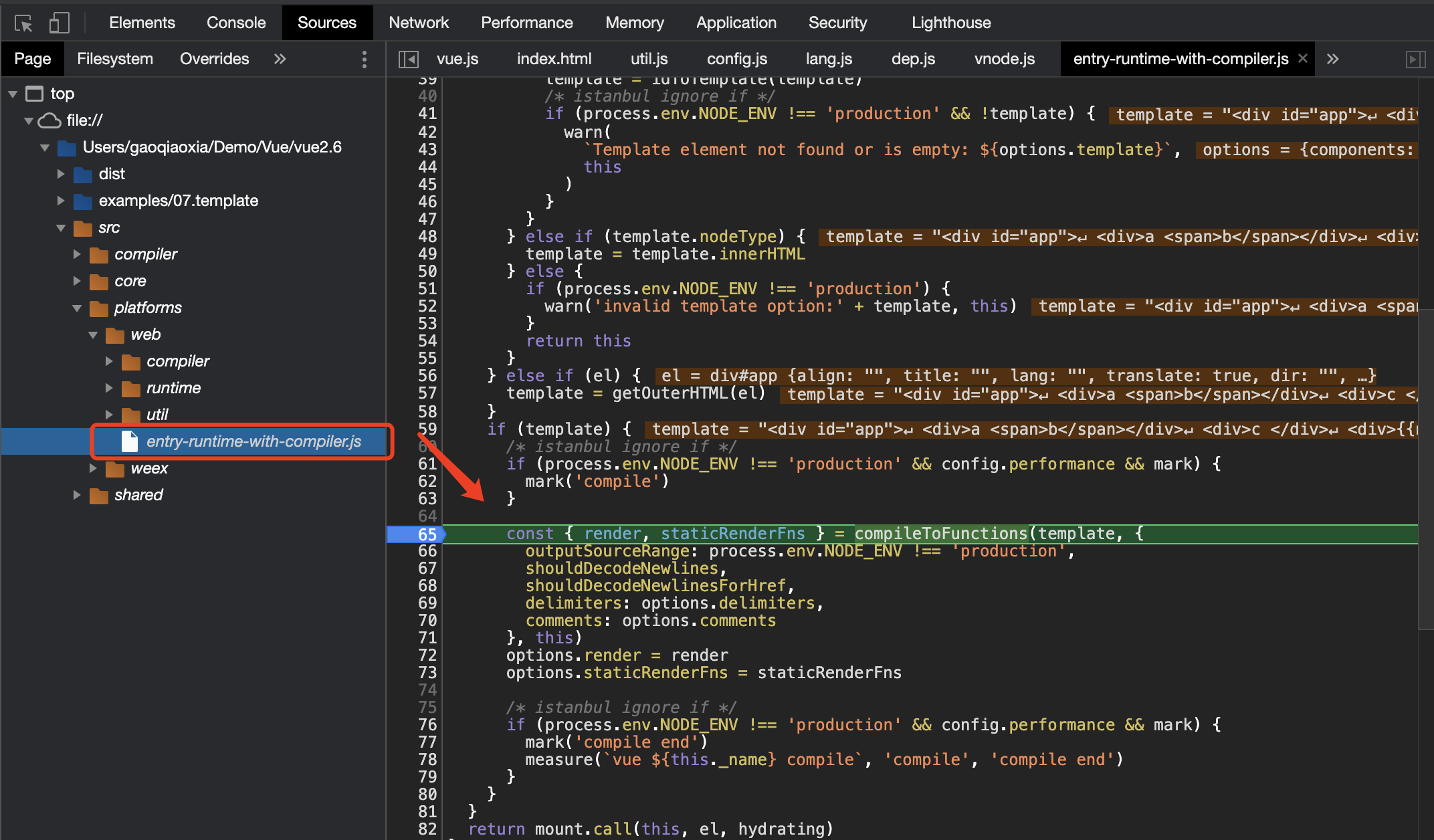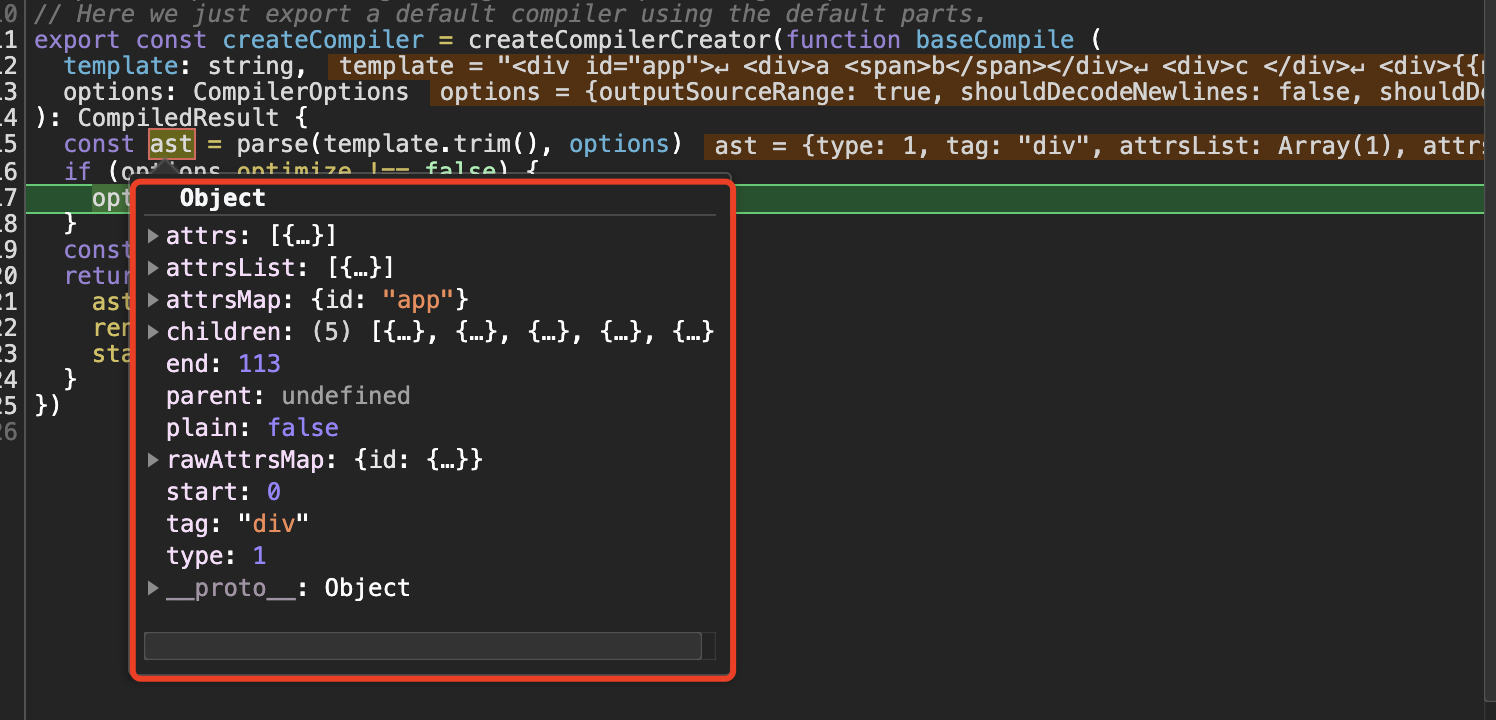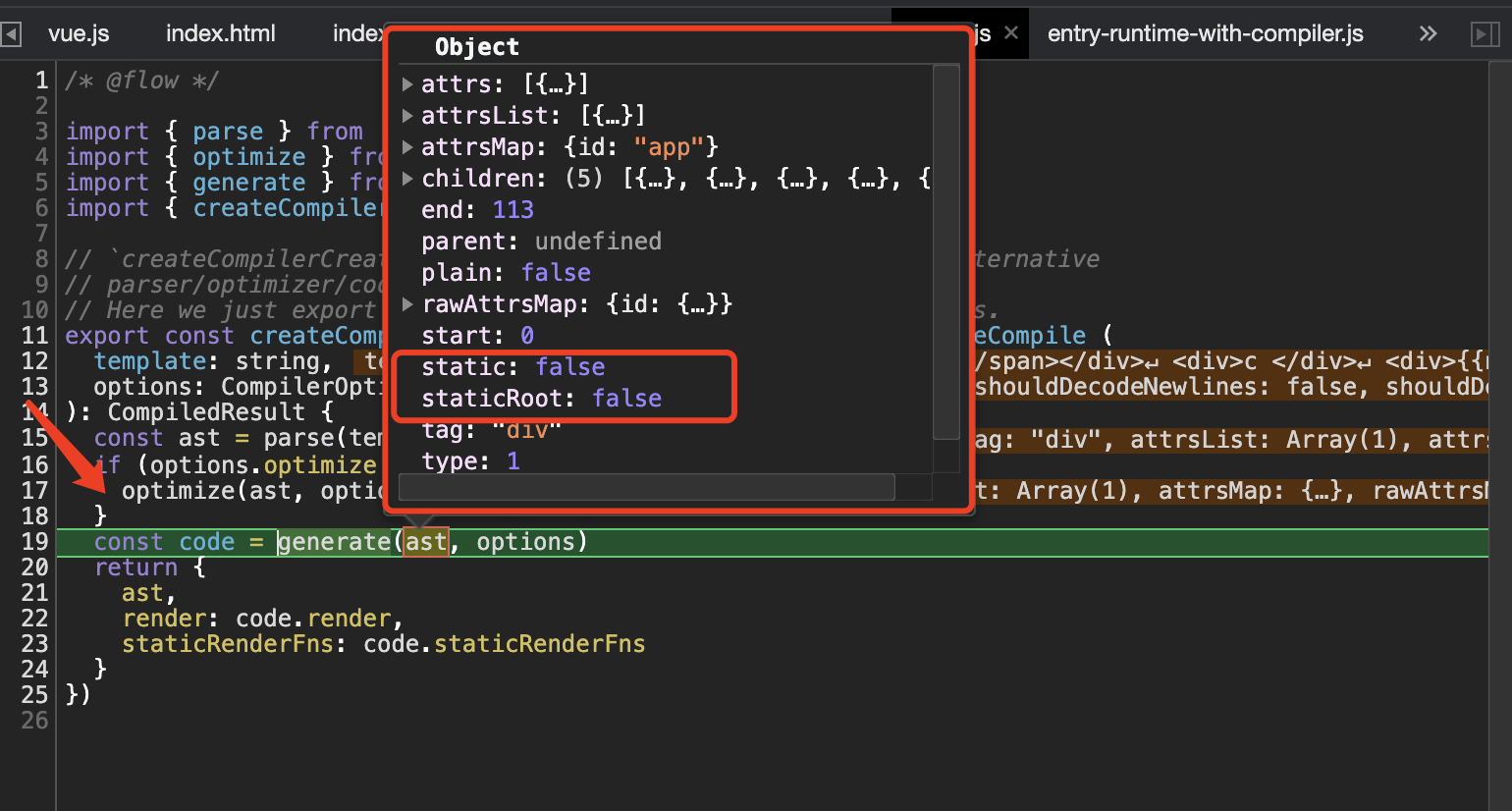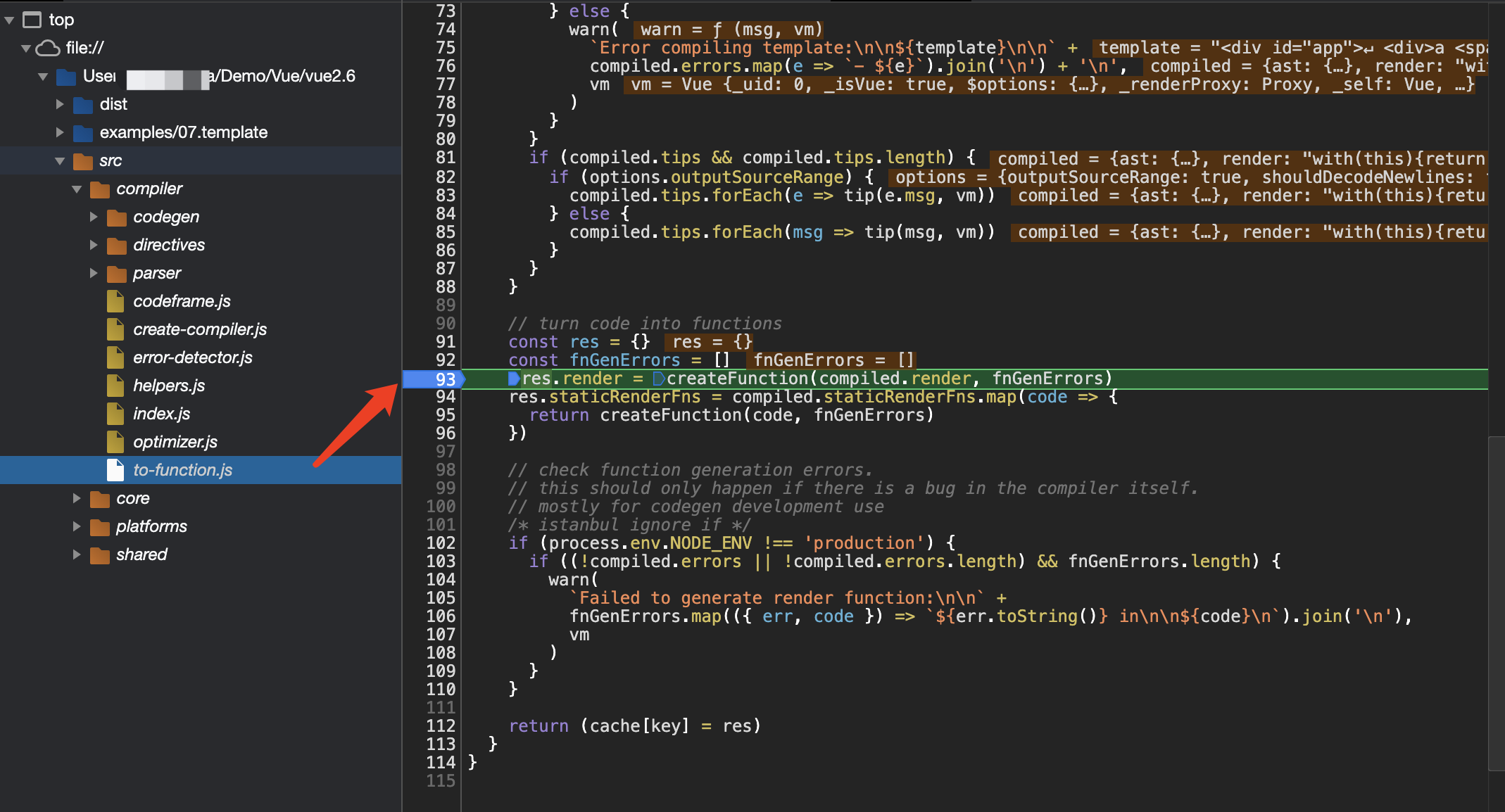Vue 模版编译的过程
对于我们经常使用框架,却不知道内部具体经历过了什么,确实好奇到不行,接下来我们以 断点的形式 进入,看看是怎么将 模版 转化为 虚拟 Dom 进行操作的。 Go, Go,Go,玩起来
具体经历步骤
1、从缓存中读取 Render 函数
2、将模版转化成 AST
3、AST 优化
4、AST 转化为 js 字符串
5、JS 字符串 转化为 匿名函数
6、Render 函数 = 匿名函数
7、Render 函数 转化为 Vnode
8、将 Vnode 创建成为 真实 Dom
9、Node 标签放入页面中
一、 预备工作
1. Vue2.6 源码的 clone
2. 浏览器,我用的是 google
3. 浏览器内断点操作
二、新建 html
在 Vue2.6 源码目录下,找到 examples 文件夹,新建 /07.template/index.html , 以下为 html 内部代码
<!DOCTYPE html>
<html lang="en">
<head>
<meta charset="UTF-8">
<meta name="viewport" content="width=device-width, initial-scale=1.0">
<title>Document</title>
</head>
<body>
<div id="app">
<div>a <span>b</span></div>
<div>c </div>
<div>{{name}} <span>e</span> </div>
</div>
<script src="../../dist/vue.js"></script>
<script>
const vm = new Vue({
el: '#app',
data: {
name: 'd'
}
})
</script>
</body>
</html>
三、断点
打开 google 浏览器,F12 找到 sources, 根据下面图片,找到 src/platforms/web/entry-runtime-with-compiler.js 对比的文件,并进行断点

二. 详细注解
一、从缓存中读取 Render 函数
// vue2.6/src/compiler/to-function.js
// check cache const key = options.delimiters ? String(options.delimiters) + template : template if (cache[key]) { return cache[key] // 读取缓存 }
function compile (
template: string,
options?: CompilerOptions
): CompiledResult {
const finalOptions = Object.create(baseOptions)
const errors = []
const tips = []
let warn = (msg, range, tip) => {
(tip ? tips : errors).push(msg)
}
if (options) {
if (process.env.NODE_ENV !== 'production' && options.outputSourceRange) {
// $flow-disable-line
const leadingSpaceLength = template.match(/^\s*/)[0].length
warn = (msg, range, tip) => {
const data: WarningMessage = { msg }
if (range) {
if (range.start != null) {
data.start = range.start + leadingSpaceLength
}
if (range.end != null) {
data.end = range.end + leadingSpaceLength
}
}
(tip ? tips : errors).push(data)
}
}
// merge custom modules
if (options.modules) {
finalOptions.modules =
(baseOptions.modules || []).concat(options.modules)
}
// merge custom directives
if (options.directives) {
finalOptions.directives = extend(
Object.create(baseOptions.directives || null),
options.directives
)
}
// copy other options
for (const key in options) {
if (key !== 'modules' && key !== 'directives') {
finalOptions[key] = options[key]
}
}
}
finalOptions.warn = warn
const compiled = baseCompile(template.trim(), finalOptions) // 将模版转化成 AST
if (process.env.NODE_ENV !== 'production') {
detectErrors(compiled.ast, warn)
}
compiled.errors = errors
compiled.tips = tips
return compiled
}
二、将模版转化成 AST
export const createCompiler = createCompilerCreator(function baseCompile (
template: string,
options: CompilerOptions
): CompiledResult {
const ast = parse(template.trim(), options) // 模版转化成 AST
if (options.optimize !== false) {
optimize(ast, options)
}
})
2. parse()

/**
* Convert HTML string to AST.
*/
export function parse (
template: string,
options: CompilerOptions
): ASTElement | void {
warn = options.warn || baseWarn
platformIsPreTag = options.isPreTag || no
platformMustUseProp = options.mustUseProp || no
platformGetTagNamespace = options.getTagNamespace || no
const isReservedTag = options.isReservedTag || no
maybeComponent = (el: ASTElement) => !!el.component || !isReservedTag(el.tag)
transforms = pluckModuleFunction(options.modules, 'transformNode')
preTransforms = pluckModuleFunction(options.modules, 'preTransformNode')
postTransforms = pluckModuleFunction(options.modules, 'postTransformNode')
delimiters = options.delimiters
const stack = []
const preserveWhitespace = options.preserveWhitespace !== false
const whitespaceOption = options.whitespace
let root
let currentParent
let inVPre = false
let inPre = false
let warned = false
function warnOnce (msg, range) {
if (!warned) {
warned = true
warn(msg, range)
}
}
function closeElement (element) {
if (!inVPre && !element.processed) {
element = processElement(element, options)
}
// tree management
if (!stack.length && element !== root) {
// allow root elements with v-if, v-else-if and v-else
if (root.if && (element.elseif || element.else)) {
if (process.env.NODE_ENV !== 'production') {
checkRootConstraints(element)
}
addIfCondition(root, {
exp: element.elseif,
block: element
})
} else if (process.env.NODE_ENV !== 'production') {
warnOnce(
`Component template should contain exactly one root element. ` +
`If you are using v-if on multiple elements, ` +
`use v-else-if to chain them instead.`,
{ start: element.start }
)
}
}
if (currentParent && !element.forbidden) {
if (element.elseif || element.else) {
processIfConditions(element, currentParent)
} else if (element.slotScope) { // scoped slot
const name = element.slotTarget || '"default"'
;(currentParent.scopedSlots || (currentParent.scopedSlots = {}))[name] = element
} else {
currentParent.children.push(element)
element.parent = currentParent
}
}
// check pre state
if (element.pre) {
inVPre = false
}
if (platformIsPreTag(element.tag)) {
inPre = false
}
// apply post-transforms
for (let i = 0; i < postTransforms.length; i++) {
postTransforms[i](element, options)
}
}
function checkRootConstraints (el) {
if (el.tag === 'slot' || el.tag === 'template') {
warnOnce(
`Cannot use <${el.tag}> as component root element because it may ` +
'contain multiple nodes.',
{ start: el.start }
)
}
if (hasOwn(el.attrsMap, 'v-for')) {
warnOnce(
'Cannot use v-for on stateful component root element because ' +
'it renders multiple elements.',
el.rawAttrsMap['v-for']
)
}
}
parseHTML(template, {
warn,
expectHTML: options.expectHTML,
isUnaryTag: options.isUnaryTag,
canBeLeftOpenTag: options.canBeLeftOpenTag,
shouldDecodeNewlines: options.shouldDecodeNewlines,
shouldDecodeNewlinesForHref: options.shouldDecodeNewlinesForHref,
shouldKeepComment: options.comments,
outputSourceRange: options.outputSourceRange,
start (tag, attrs, unary, start) {
// check namespace.
// inherit parent ns if there is one
const ns = (currentParent && currentParent.ns) || platformGetTagNamespace(tag)
// handle IE svg bug
/* istanbul ignore if */
if (isIE && ns === 'svg') {
attrs = guardIESVGBug(attrs)
}
let element: ASTElement = createASTElement(tag, attrs, currentParent)
if (ns) {
element.ns = ns
}
if (process.env.NODE_ENV !== 'production' && options.outputSourceRange) {
element.start = start
element.rawAttrsMap = element.attrsList.reduce((cumulated, attr) => {
cumulated[attr.name] = attr
return cumulated
}, {})
}
if (isForbiddenTag(element) && !isServerRendering()) {
element.forbidden = true
process.env.NODE_ENV !== 'production' && warn(
'Templates should only be responsible for mapping the state to the ' +
'UI. Avoid placing tags with side-effects in your templates, such as ' +
`<${tag}>` + ', as they will not be parsed.',
{ start: element.start }
)
}
// apply pre-transforms
for (let i = 0; i < preTransforms.length; i++) {
element = preTransforms[i](element, options) || element
}
if (!inVPre) {
processPre(element)
if (element.pre) {
inVPre = true
}
}
if (platformIsPreTag(element.tag)) {
inPre = true
}
if (inVPre) {
processRawAttrs(element)
} else if (!element.processed) {
// structural directives
processFor(element)
processIf(element)
processOnce(element)
}
if (!root) {
root = element
if (process.env.NODE_ENV !== 'production') {
checkRootConstraints(root)
}
}
if (!unary) {
currentParent = element
stack.push(element)
} else {
closeElement(element)
}
},
end (tag, start, end) {
const element = stack[stack.length - 1]
if (!inPre) {
// remove trailing whitespace node
const lastNode = element.children[element.children.length - 1]
if (lastNode && lastNode.type === 3 && lastNode.text === ' ') {
element.children.pop()
}
}
// pop stack
stack.length -= 1
currentParent = stack[stack.length - 1]
if (process.env.NODE_ENV !== 'production' && options.outputSourceRange) {
element.end = end
}
closeElement(element)
},
chars (text: string, start: number, end: number) {
if (!currentParent) {
if (process.env.NODE_ENV !== 'production') {
if (text === template) {
warnOnce(
'Component template requires a root element, rather than just text.',
{ start }
)
} else if ((text = text.trim())) {
warnOnce(
`text "${text}" outside root element will be ignored.`,
{ start }
)
}
}
return
}
// IE textarea placeholder bug
/* istanbul ignore if */
if (isIE &&
currentParent.tag === 'textarea' &&
currentParent.attrsMap.placeholder === text
) {
return
}
const children = currentParent.children
if (inPre || text.trim()) {
text = isTextTag(currentParent) ? text : decodeHTMLCached(text)
} else if (!children.length) {
// remove the whitespace-only node right after an opening tag
text = ''
} else if (whitespaceOption) {
if (whitespaceOption === 'condense') {
// in condense mode, remove the whitespace node if it contains
// line break, otherwise condense to a single space
text = lineBreakRE.test(text) ? '' : ' '
} else {
text = ' '
}
} else {
text = preserveWhitespace ? ' ' : ''
}
if (text) {
if (whitespaceOption === 'condense') {
// condense consecutive whitespaces into single space
text = text.replace(whitespaceRE, ' ')
}
let res
let child: ?ASTNode
if (!inVPre && text !== ' ' && (res = parseText(text, delimiters))) {
child = {
type: 2,
expression: res.expression,
tokens: res.tokens,
text
}
} else if (text !== ' ' || !children.length || children[children.length - 1].text !== ' ') {
child = {
type: 3,
text
}
}
if (child) {
if (process.env.NODE_ENV !== 'production' && options.outputSourceRange) {
child.start = start
child.end = end
}
children.push(child)
}
}
},
comment (text: string, start, end) {
const child: ASTText = {
type: 3,
text,
isComment: true
}
if (process.env.NODE_ENV !== 'production' && options.outputSourceRange) {
child.start = start
child.end = end
}
currentParent.children.push(child)
}
})
return root
}

三、AST 优化
export const createCompiler = createCompilerCreator(function baseCompile (
template: string,
options: CompilerOptions
): CompiledResult {
const ast = parse(template.trim(), options)
if (options.optimize !== false) {
optimize(ast, options)
}
const code = generate(ast, options)
return {
ast,
render: code.render,
staticRenderFns: code.staticRenderFns
}
})
2. AST 新增 静态节点后的显示

四、AST 转化为 js 字符串
export function generate (
ast: ASTElement | void,
options: CompilerOptions
): CodegenResult {
const state = new CodegenState(options)
const code = ast ? genElement(ast, state) : '_c("div")' // AST 转化为 js 字符串,内部包含 _c,_v.....
return {
render: `with(this){return ${code}}`,
staticRenderFns: state.staticRenderFns
}
}
export const createCompiler = createCompilerCreator(function baseCompile (
template: string,
options: CompilerOptions
): CompiledResult {
const ast = parse(template.trim(), options)
if (options.optimize !== false) {
optimize(ast, options)
}
const code = generate(ast, options) // AST 转化为 js 字符串,加 with(this){return ${code}}
return {
ast,
render: code.render,
staticRenderFns: code.staticRenderFns
}
})
五、JS 字符串 转化为 匿名函数

function createFunction (code, errors) {
try {
return new Function(code)
} catch (err) {
errors.push({ err, code })
return noop
}
}
with(this){return ${code}}
六、Render 函数 = 匿名函数
// turn code into functions
const res = {}
const fnGenErrors = []
res.render = createFunction(compiled.render, fnGenErrors)
res.staticRenderFns = compiled.staticRenderFns.map(code => {
return createFunction(code, fnGenErrors)
})
// check function generation errors.
// this should only happen if there is a bug in the compiler itself.
// mostly for codegen development use
/* istanbul ignore if */
if (process.env.NODE_ENV !== 'production') {
if ((!compiled.errors || !compiled.errors.length) && fnGenErrors.length) {
warn(
`Failed to generate render function:\n\n` +
fnGenErrors.map(({ err, code }) => `${err.toString()} in\n\n${code}\n`).join('\n'),
vm
)
}
}
return (cache[key] = res) // 将 匿名函数的 Render,staticRenderFns 存储在缓存中
}
七、Render 函数 转化为 Vnode
1. Render 存在缓存中后,我们就需要通过👇,将 Render 函数 转化为 Vnode
mount.call(this, el, hydrating)
// public mount method
Vue.prototype.$mount = function (
el?: string | Element,
hydrating?: boolean
): Component {
el = el && inBrowser ? query(el) : undefined
return mountComponent(this, el, hydrating)
}
强调:在生产环境中,el 只会有这一次的赋值,但在开发环境中需要将 el 再次赋值
2. mountComponent( vm, el, hydrating) Vm.$el = el,将 el 挂载到 Vue 实例上
export function mountComponent(
vm: Component,
el: ?Element,
hydrating?: boolean
): Component {
vm.$el = el // 将 el 挂载到 Vue 实例上
if (!vm.$options.render) {
vm.$options.render = createEmptyVNode
if (process.env.NODE_ENV !== 'production') {
/* istanbul ignore if */
if ((vm.$options.template && vm.$options.template.charAt(0) !== '#') ||
vm.$options.el || el) {
warn(
'You are using the runtime-only build of Vue where the template ' +
'compiler is not available. Either pre-compile the templates into ' +
'render functions, or use the compiler-included build.',
vm
)
} else {
warn(
'Failed to mount component: template or render function not defined.',
vm
)
}
}
}
callHook(vm, 'beforeMount')
let updateComponent
/* istanbul ignore if */
if (process.env.NODE_ENV !== 'production' && config.performance && mark) {
updateComponent = () => {
const name = vm._name
const id = vm._uid
const startTag = `vue-perf-start:${id}`
const endTag = `vue-perf-end:${id}`
mark(startTag)
const vnode = vm._render()
mark(endTag)
measure(`vue ${name} render`, startTag, endTag)
mark(startTag)
vm._update(vnode, hydrating)
mark(endTag)
measure(`vue ${name} patch`, startTag, endTag)
}
} else {
// vm._render() 渲染虚拟 Dom
// vm._update() 将虚拟 Dom 转换成真实 Dom
updateComponent = () => {
vm._update(vm._render(), hydrating)
}
}
// we set this to vm._watcher inside the watcher's constructor
// since the watcher's initial patch may call $forceUpdate (e.g. inside child
// component's mounted hook), which relies on vm._watcher being already defined
/**
* @param vm vue实例
* @param {Function} updateComponent 将虚拟Dom更新为真实dom
* @param {Function} noop 空的函数,只针对用户 watcher和computed watcher
* @param {object} 触发beforeUpdate函数
* @param {boolean} isRenderWatcher 标记当前的watcher是渲染watcher
*/
new Watcher(vm, updateComponent, noop, {
before() {
if (vm._isMounted && !vm._isDestroyed) {
callHook(vm, 'beforeUpdate')
}
}
}, true /* isRenderWatcher */)
hydrating = false
// manually mounted instance, call mounted on self
// mounted is called for render-created child components in its inserted hook
if (vm.$vnode == null) {
vm._isMounted = true
callHook(vm, 'mounted')
}
return vm
}
export function renderMixin (Vue: Class<Component>) {
// install runtime convenience helpers
installRenderHelpers(Vue.prototype)
Vue.prototype.$nextTick = function (fn: Function) {
return nextTick(fn, this)
}
Vue.prototype._render = function (): VNode {
const vm: Component = this
const { render, _parentVnode } = vm.$options
if (_parentVnode) {
vm.$scopedSlots = normalizeScopedSlots(
_parentVnode.data.scopedSlots,
vm.$slots
)
}
// set parent vnode. this allows render functions to have access
// to the data on the placeholder node.
vm.$vnode = _parentVnode
// render self
let vnode
try {
vnode = render.call(vm._renderProxy, vm.$createElement) // 将 Render 函数转化成 Vnode
} catch (e) {
handleError(e, vm, `render`)
// return error render result,
// or previous vnode to prevent render error causing blank component
/* istanbul ignore else */
if (process.env.NODE_ENV !== 'production' && vm.$options.renderError) {
try {
vnode = vm.$options.renderError.call(vm._renderProxy, vm.$createElement, e)
} catch (e) {
handleError(e, vm, `renderError`)
vnode = vm._vnode
}
} else {
vnode = vm._vnode
}
}
// if the returned array contains only a single node, allow it
if (Array.isArray(vnode) && vnode.length === 1) {
vnode = vnode[0]
}
// return empty vnode in case the render function errored out
if (!(vnode instanceof VNode)) {
if (process.env.NODE_ENV !== 'production' && Array.isArray(vnode)) {
warn(
'Multiple root nodes returned from render function. Render function ' +
'should return a single root node.',
vm
)
}
vnode = createEmptyVNode()
}
// set parent
vnode.parent = _parentVnode
return vnode
}
}
5. F11 进入 render.call 我们来看看 如何将 Render函数转化成 Vnode
(function anonymous(
) {
with(this){return _c('div',{attrs:{"id":"app"}},[_m(0),_v(" "),_c('div',[_v("c ")]),_v(" "),_c('div',[_v(_s(name)+" "),_c('span',[_v("e")])])])}
})
6. 看到 anonymous 函数后, _c, _v, _s ,_m具体是什么呢?
src/core/instance/render-helpers/index.js
/* @flow */
import { toNumber, toString, looseEqual, looseIndexOf } from 'shared/util'
import { createTextVNode, createEmptyVNode } from 'core/vdom/vnode'
import { renderList } from './render-list'
import { renderSlot } from './render-slot'
import { resolveFilter } from './resolve-filter'
import { checkKeyCodes } from './check-keycodes'
import { bindObjectProps } from './bind-object-props'
import { renderStatic, markOnce } from './render-static'
import { bindObjectListeners } from './bind-object-listeners'
import { resolveScopedSlots } from './resolve-slots'
export function installRenderHelpers (target: any) {
target._o = markOnce
target._n = toNumber
target._s = toString // 转化成字符串
target._l = renderList
target._t = renderSlot
target._q = looseEqual
target._i = looseIndexOf
target._m = renderStatic // 用于渲染静态树的运行时帮助程序
target._f = resolveFilter
target._k = checkKeyCodes
target._b = bindObjectProps
target._v = createTextVNode // 创建 Vnode 文本节点
target._e = createEmptyVNode
target._u = resolveScopedSlots
target._g = bindObjectListeners
}
7. 上面函数中是没有 _c 函数的, 继续在源码中找,我们发现 _c最终是由 createElement 转化而来的,createElement就是创建 虚拟Dom
src/core/instance/render.js
export function initRender(vm: Component) {
vm._vnode = null // the root of the child tree
vm._staticTrees = null // v-once cached trees
const options = vm.$options
const parentVnode = vm.$vnode = options._parentVnode // the placeholder node in parent tree
const renderContext = parentVnode && parentVnode.context
vm.$slots = resolveSlots(options._renderChildren, renderContext)
vm.$scopedSlots = emptyObject
// bind the createElement fn to this instance
// so that we get proper render context inside it.
// args order: tag, data, children, normalizationType, alwaysNormalize
// internal version is used by render functions compiled from templates
vm._c = (a, b, c, d) => createElement(vm, a, b, c, d, false)
// normalization is always applied for the public version, used in
// user-written render functions.
vm.$createElement = (a, b, c, d) => createElement(vm, a, b, c, d, true)
// $attrs & $listeners are exposed for easier HOC creation.
// they need to be reactive so that HOCs using them are always updated
const parentData = parentVnode && parentVnode.data
/* istanbul ignore else */
if (process.env.NODE_ENV !== 'production') {
defineReactive(vm, '$attrs', parentData && parentData.attrs || emptyObject, () => {
!isUpdatingChildComponent && warn(`$attrs is readonly.`, vm)
}, true)
defineReactive(vm, '$listeners', options._parentListeners || emptyObject, () => {
!isUpdatingChildComponent && warn(`$listeners is readonly.`, vm)
}, true)
} else {
defineReactive(vm, '$attrs', parentData && parentData.attrs || emptyObject, null, true)
defineReactive(vm, '$listeners', options._parentListeners || emptyObject, null, true)
}
}
8. 我们来看一下,createElement 具体做了什么?看到_createElemt 函数中,最终返回的是 Vnode,我们就明白了,最终 _c 是将其转化成 Vnode
// wrapper function for providing a more flexible interface
// without getting yelled at by flow
export function createElement (
context: Component,
tag: any,
data: any,
children: any,
normalizationType: any,
alwaysNormalize: boolean
): VNode | Array<VNode> {
if (Array.isArray(data) || isPrimitive(data)) {
normalizationType = children
children = data
data = undefined
}
if (isTrue(alwaysNormalize)) {
normalizationType = ALWAYS_NORMALIZE
}
return _createElement(context, tag, data, children, normalizationType)
}
export function _createElement (
context: Component,
tag?: string | Class<Component> | Function | Object,
data?: VNodeData,
children?: any,
normalizationType?: number
): VNode | Array<VNode> {
if (isDef(data) && isDef((data: any).__ob__)) {
process.env.NODE_ENV !== 'production' && warn(
`Avoid using observed data object as vnode data: ${JSON.stringify(data)}\n` +
'Always create fresh vnode data objects in each render!',
context
)
return createEmptyVNode()
}
// object syntax in v-bind
if (isDef(data) && isDef(data.is)) {
tag = data.is
}
if (!tag) {
// in case of component :is set to falsy value
return createEmptyVNode()
}
// warn against non-primitive key
if (process.env.NODE_ENV !== 'production' &&
isDef(data) && isDef(data.key) && !isPrimitive(data.key)
) {
if (!__WEEX__ || !('@binding' in data.key)) {
warn(
'Avoid using non-primitive value as key, ' +
'use string/number value instead.',
context
)
}
}
// support single function children as default scoped slot
if (Array.isArray(children) &&
typeof children[0] === 'function'
) {
data = data || {}
data.scopedSlots = { default: children[0] }
children.length = 0
}
if (normalizationType === ALWAYS_NORMALIZE) {
children = normalizeChildren(children)
} else if (normalizationType === SIMPLE_NORMALIZE) {
children = simpleNormalizeChildren(children)
}
let vnode, ns
if (typeof tag === 'string') {
let Ctor
ns = (context.$vnode && context.$vnode.ns) || config.getTagNamespace(tag)
if (config.isReservedTag(tag)) {
// platform built-in elements
vnode = new VNode(
config.parsePlatformTagName(tag), data, children,
undefined, undefined, context
)
} else if ((!data || !data.pre) && isDef(Ctor = resolveAsset(context.$options, 'components', tag))) {
// component
vnode = createComponent(Ctor, data, context, children, tag)
} else {
// unknown or unlisted namespaced elements
// check at runtime because it may get assigned a namespace when its
// parent normalizes children
vnode = new VNode(
tag, data, children,
undefined, undefined, context
)
}
} else {
// direct component options / constructor
vnode = createComponent(tag, data, context, children)
}
if (Array.isArray(vnode)) {
return vnode
} else if (isDef(vnode)) {
if (isDef(ns)) applyNS(vnode, ns)
if (isDef(data)) registerDeepBindings(data)
return vnode
} else {
return createEmptyVNode()
}
}
9. 瞅瞅 JS 字符串,转化成 Vnode 是什么样的?

9.具体如何转化成的Vnode,小伙伴们可自行研究,后续博客再加入Vnode的转化详细注解
八、将 Vnode 创建成为 真实 Dom
Vue.prototype._update = function (vnode: VNode, hydrating?: boolean) {
const vm: Component = this
const prevEl = vm.$el
const prevVnode = vm._vnode
const restoreActiveInstance = setActiveInstance(vm)
vm._vnode = vnode
// Vue.prototype.__patch__ is injected in entry points
// based on the rendering backend used.
if (!prevVnode) {
// initial render
vm.$el = vm.__patch__(vm.$el, vnode, hydrating, false /* removeOnly */)
} else {
// updates
vm.$el = vm.__patch__(prevVnode, vnode)
}
restoreActiveInstance()
// update __vue__ reference
if (prevEl) {
prevEl.__vue__ = null
}
if (vm.$el) {
vm.$el.__vue__ = vm
}
// if parent is an HOC, update its $el as well
if (vm.$vnode && vm.$parent && vm.$vnode === vm.$parent._vnode) {
vm.$parent.$el = vm.$el
}
// updated hook is called by the scheduler to ensure that children are
// updated in a parent's updated hook.
}
2. 看到上面我们就不难发现,将 Vnode 转化成 真实 Dom 是通过 __patch__ , 来看一下__patch__具体做了什么?__patch__这个地方做了很多操作,下次详细讲解
- 解析 Vnode,并将 指令,变量进行转化
- updateChildren 新旧 Vnode的对比
- 创建 createElm 真实 Dom
return function patch (oldVnode, vnode, hydrating, removeOnly) {
if (isUndef(vnode)) {
if (isDef(oldVnode)) invokeDestroyHook(oldVnode)
return
}
let isInitialPatch = false
const insertedVnodeQueue = []
if (isUndef(oldVnode)) {
// empty mount (likely as component), create new root element
isInitialPatch = true
createElm(vnode, insertedVnodeQueue)
} else {
const isRealElement = isDef(oldVnode.nodeType)
if (!isRealElement && sameVnode(oldVnode, vnode)) {
// patch existing root node
patchVnode(oldVnode, vnode, insertedVnodeQueue, null, null, removeOnly)
} else {
if (isRealElement) {
// mounting to a real element
// check if this is server-rendered content and if we can perform
// a successful hydration.
if (oldVnode.nodeType === 1 && oldVnode.hasAttribute(SSR_ATTR)) {
oldVnode.removeAttribute(SSR_ATTR)
hydrating = true
}
if (isTrue(hydrating)) {
if (hydrate(oldVnode, vnode, insertedVnodeQueue)) {
invokeInsertHook(vnode, insertedVnodeQueue, true)
return oldVnode
} else if (process.env.NODE_ENV !== 'production') {
warn(
'The client-side rendered virtual DOM tree is not matching ' +
'server-rendered content. This is likely caused by incorrect ' +
'HTML markup, for example nesting block-level elements inside ' +
'<p>, or missing <tbody>. Bailing hydration and performing ' +
'full client-side render.'
)
}
}
// either not server-rendered, or hydration failed.
// create an empty node and replace it
oldVnode = emptyNodeAt(oldVnode)
}
// replacing existing element
const oldElm = oldVnode.elm
const parentElm = nodeOps.parentNode(oldElm)
// create new node
createElm(
vnode,
insertedVnodeQueue,
// extremely rare edge case: do not insert if old element is in a
// leaving transition. Only happens when combining transition +
// keep-alive + HOCs. (#4590)
oldElm._leaveCb ? null : parentElm,
nodeOps.nextSibling(oldElm)
)
// update parent placeholder node element, recursively
if (isDef(vnode.parent)) {
let ancestor = vnode.parent
const patchable = isPatchable(vnode)
while (ancestor) {
for (let i = 0; i < cbs.destroy.length; ++i) {
cbs.destroy[i](ancestor)
}
ancestor.elm = vnode.elm
if (patchable) {
for (let i = 0; i < cbs.create.length; ++i) {
cbs.create[i](emptyNode, ancestor)
}
// #6513
// invoke insert hooks that may have been merged by create hooks.
// e.g. for directives that uses the "inserted" hook.
const insert = ancestor.data.hook.insert
if (insert.merged) {
// start at index 1 to avoid re-invoking component mounted hook
for (let i = 1; i < insert.fns.length; i++) {
insert.fns[i]()
}
}
} else {
registerRef(ancestor)
}
ancestor = ancestor.parent
}
}
// destroy old node
if (isDef(parentElm)) {
removeVnodes(parentElm, [oldVnode], 0, 0)
} else if (isDef(oldVnode.tag)) {
invokeDestroyHook(oldVnode)
}
}
}
invokeInsertHook(vnode, insertedVnodeQueue, isInitialPatch)
return vnode.elm
}
}




